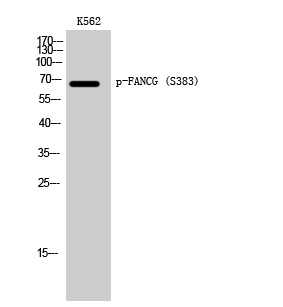FANCG (phospho Ser383) Polyclonal Antibody
- Catalog No.:YP0455
- Applications:WB;ELISA
- Reactivity:Human;Rat;Mouse;
- Target:
- FANCG
- Fields:
- >>Fanconi anemia pathway
- Gene Name:
- FANCG
- Protein Name:
- Fanconi anemia group G protein
- Human Gene Id:
- 2189
- Human Swiss Prot No:
- O15287
- Mouse Swiss Prot No:
- Q9EQR6
- Immunogen:
- Synthesized phospho-peptide around the phosphorylation site of human FANCG (phospho Ser383)
- Specificity:
- Phospho-FANCG (S383) Polyclonal Antibody detects endogenous levels of FANCG protein only when phosphorylated at S383.
- Formulation:
- Liquid in PBS containing 50% glycerol, 0.5% BSA and 0.02% sodium azide.
- Source:
- Polyclonal, Rabbit,IgG
- Dilution:
- WB 1:500 - 1:2000. ELISA: 1:40000. Not yet tested in other applications.
- Purification:
- The antibody was affinity-purified from rabbit antiserum by affinity-chromatography using epitope-specific immunogen.
- Concentration:
- 1 mg/ml
- Storage Stability:
- -15°C to -25°C/1 year(Do not lower than -25°C)
- Other Name:
- FANCG;XRCC9;Fanconi anemia group G protein;Protein FACG;DNA repair protein XRCC9
- Observed Band(KD):
- 69kD
- Background:
- The Fanconi anemia complementation group (FANC) currently includes FANCA, FANCB, FANCC, FANCD1 (also called BRCA2), FANCD2, FANCE, FANCF, FANCG, FANCI, FANCJ (also called BRIP1), FANCL, FANCM and FANCN (also called PALB2). The previously defined group FANCH is the same as FANCA. Fanconi anemia is a genetically heterogeneous recessive disorder characterized by cytogenetic instability, hypersensitivity to DNA crosslinking agents, increased chromosomal breakage, and defective DNA repair. The members of the Fanconi anemia complementation group do not share sequence similarity; they are related by their assembly into a common nuclear protein complex. This gene encodes the protein for complementation group G. [provided by RefSeq, Jul 2008],
- Function:
- disease:Defects in FANCG are a cause of Fanconi anemia (FA) [MIM:227650]. FA is a genetically heterogeneous, autosomal recessive disorder characterized by progressive pancytopenia, a diverse assortment of congenital malformations, and a predisposition to the development of malignancies. At the cellular level it is associated with hypersensitivity to DNA-damaging agents, chromosomal instability (increased chromosome breakage), and defective DNA repair.,function:DNA repair protein that may operate in a postreplication repair or a cell cycle checkpoint function. May be implicated in interstrand DNA cross-link repair and in the maintenance of normal chromosome stability. Candidate tumor suppressor gene.,similarity:Contains 4 TPR repeats.,subcellular location:The major form is nuclear. The minor form is cytoplasmic.,subunit:Belongs to the multisubunit FA complex composed of FANCA, FANCB, FANC
- Subcellular Location:
- Nucleus . Cytoplasm . The major form is nuclear. The minor form is cytoplasmic.
- Expression:
- Highly expressed in testis and thymus. Found in lymphoblasts.
- June 19-2018
- WESTERN IMMUNOBLOTTING PROTOCOL
- June 19-2018
- IMMUNOHISTOCHEMISTRY-PARAFFIN PROTOCOL
- June 19-2018
- IMMUNOFLUORESCENCE PROTOCOL
- September 08-2020
- FLOW-CYTOMEYRT-PROTOCOL
- May 20-2022
- Cell-Based ELISA│解您多样本WB检测之困扰
- July 13-2018
- CELL-BASED-ELISA-PROTOCOL-FOR-ACETYL-PROTEIN
- July 13-2018
- CELL-BASED-ELISA-PROTOCOL-FOR-PHOSPHO-PROTEIN
- July 13-2018
- Antibody-FAQs
- Products Images

- Western Blot analysis of K562 cells using Phospho-FANCG (S383) Polyclonal Antibody



